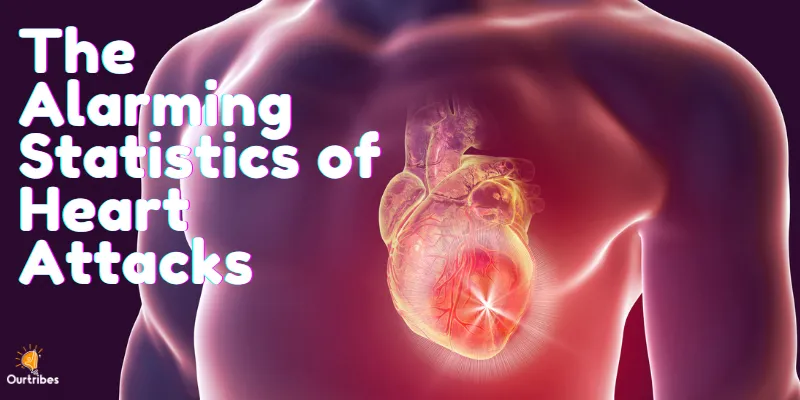
Understanding Heart Attack Risks: Essential Blood Markers to Monitor
Heart attacks are a leading cause of death worldwide, with alarming statistics highlighting their prevalence. This blog delves into how to identify heart attack risks through comprehensive blood tests, emphasizing the importance of understanding various blood markers beyond the basics. Learn how to take proactive steps for your heart health by monitoring the right indicators.
The Alarming Statistics of Heart Attacks
Heart attacks are a critical health issue that affects millions around the globe. In fact, a startling statistic reveals that someone dies from a heart attack every 30 seconds worldwide. In 2022 alone, approximately 702,000 individuals succumbed to heart attacks in the United States, indicating that 20% of those affected by heart attacks do not survive. These numbers underscore the urgent need for awareness and proactive measures to monitor heart health.
The Prevalence of Heart Disease
Heart disease remains the leading cause of death in many countries. The increasing rates can be attributed to various factors, including lifestyle choices, dietary habits, and genetic predispositions. With rising incidences, it is crucial to educate individuals about the importance of heart health monitoring.
Understanding Risk Factors
Several risk factors contribute to heart attacks, including high cholesterol levels, hypertension, obesity, smoking, and sedentary lifestyles. Understanding these factors is vital for prevention. Regular health check-ups and blood tests can help identify these risks early.
The Importance of Early Detection
Detecting potential heart issues early can significantly improve outcomes. Comprehensive testing provides insights into an individual's heart health and helps identify those at risk before a heart attack occurs. This proactive approach can save lives.
Introduction to Heart Health Monitoring
Monitoring heart health involves regular assessments of various indicators that can signal potential issues. These indicators include blood pressure, cholesterol levels, and other metabolic markers. Staying informed about these metrics can empower individuals to take control of their heart health.
Key Metrics to Monitor
Blood Pressure: High blood pressure can strain the heart and arteries, leading to serious complications.
Cholesterol Levels: Monitoring LDL, HDL, and triglycerides is essential for assessing cardiovascular risk.
Blood Sugar Levels: Elevated blood sugar can indicate insulin resistance, a precursor to diabetes and heart disease.
Technological Advancements in Monitoring
With advancements in technology, heart health monitoring has become more accessible. Wearable devices and mobile applications now allow individuals to track their heart rate, activity levels, and even blood pressure on the go. This real-time data can lead to more informed health decisions.
Why Basic Tests May Not Be Enough
Many individuals rely solely on basic tests to gauge their heart health, often overlooking critical markers. While tests like cholesterol panels provide valuable information, they may not present a complete picture of cardiovascular risk.
Limitations of Basic Testing
Traditional blood tests typically focus on total cholesterol, LDL (low-density lipoprotein), and HDL (high-density lipoprotein). While these markers are important, they do not account for the nuanced interplay of various lipoproteins and inflammatory markers that can significantly impact heart health.
Understanding the Need for Comprehensive Testing
A comprehensive assessment goes beyond basic cholesterol levels. It includes evaluating additional markers that can indicate inflammation, insulin resistance, and other risk factors. By understanding these metrics, individuals can better assess their risk for heart disease.
Common Blood Tests: LDL, HDL, and Triglycerides
When it comes to understanding heart health, LDL, HDL, and triglycerides are the most commonly measured blood markers. Each plays a unique role in cardiovascular health.
LDL Cholesterol
LDL cholesterol, often referred to as "bad" cholesterol, is linked to plaque buildup in arteries. Elevated levels can lead to a higher risk of heart disease and stroke. It is essential to monitor and manage LDL levels through lifestyle changes and, if necessary, medications.
HDL Cholesterol
Conversely, HDL cholesterol is known as "good" cholesterol. It helps transport cholesterol away from the arteries and back to the liver for removal. Higher levels of HDL are associated with a lower risk of heart disease. Therefore, strategies to increase HDL, such as regular physical activity and healthy fats, are beneficial.
Triglycerides
Triglycerides are another type of fat found in the blood. Elevated triglyceride levels can contribute to the hardening of arteries and increase the risk of heart disease. Managing triglycerides often involves dietary adjustments, such as reducing sugar and refined carbohydrate intake.
Advanced Profiles: Going Beyond Basic Tests
To gain a deeper understanding of heart health, advanced lipid profiles can be instrumental. These profiles include additional markers that provide insight into cardiovascular risk beyond standard cholesterol tests.
Advanced Lipid Testing Markers
Apo A1 and Apo B: These proteins help assess the balance between good and bad cholesterol and are crucial for understanding cardiovascular risk.
Lipoprotein(a) [Lp(a)]: High levels of Lp(a) are associated with an increased risk of heart disease, even when other cholesterol levels are normal.
Small Dense LDL Particles: These particles are more atherogenic and can pose a greater risk for heart disease compared to larger LDL particles.
Inflammatory Markers
In addition to lipid profiles, measuring inflammatory markers can provide significant insight into heart health. Markers such as high-sensitivity C-reactive protein (hs-CRP) can indicate systemic inflammation, which is a risk factor for heart disease.
The Role of Insulin Resistance
Evaluating insulin resistance through fasting insulin and HOMA-IR can also provide important information about heart health. Insulin resistance can contribute to various metabolic disorders, including type 2 diabetes, which is closely linked to cardiovascular disease.
Understanding LDL and HDL Cholesterol
Cholesterol is a waxy substance found in your blood, and it plays a vital role in building cells. There are two main types of cholesterol: low-density lipoprotein (LDL) and high-density lipoprotein (HDL). Understanding the differences between these two types is crucial for assessing heart health.
LDL Cholesterol: The "Bad" Cholesterol
LDL cholesterol is often referred to as "bad" cholesterol because high levels can lead to plaque buildup in the arteries. This buildup narrows the arteries and can restrict blood flow, increasing the risk of heart disease and stroke. Monitoring LDL levels is essential for cardiovascular health.
HDL Cholesterol: The "Good" Cholesterol
HDL cholesterol, on the other hand, is known as "good" cholesterol. It helps remove cholesterol from the bloodstream, transporting it back to the liver for elimination. Higher levels of HDL cholesterol are associated with a lower risk of heart disease, making it vital to maintain healthy HDL levels.
Balancing LDL and HDL
Finding a balance between LDL and HDL is key to heart health. While high LDL levels are concerning, low HDL levels can also pose risks. Strategies to increase HDL include regular exercise, healthy fats in the diet, and avoiding trans fats.
The Role of Advanced Lipid Profiles
Advanced lipid profiles provide a more detailed analysis of cholesterol levels and their impact on heart health. These tests go beyond standard cholesterol tests, offering insights into various lipoproteins and their functions.
Components of Advanced Lipid Profiles
Apolipoproteins (Apo A1 and Apo B): Apo A1 is the main protein component of HDL, while Apo B is the primary protein found in LDL. The ratio of these proteins can indicate the balance of good and bad cholesterol in the bloodstream.
Lipoprotein(a) [Lp(a)]: Lp(a) is a type of LDL that can significantly increase heart disease risk, independent of other cholesterol levels. Elevated Lp(a) levels may require specific management strategies.
Small Dense LDL Particles: These smaller particles of LDL are more atherogenic and pose a higher risk for cardiovascular events compared to larger LDL particles. Understanding the size and density of LDL particles can provide deeper insights into heart disease risk.
Inflammation Markers: Their Importance in Heart Health
Inflammation plays a significant role in heart disease. Chronic inflammation can lead to damage in blood vessels and contribute to plaque buildup. Monitoring inflammation markers can provide valuable information about heart health.
Key Inflammation Markers
High-Sensitivity C-Reactive Protein (hs-CRP): This protein increases in response to inflammation and can be a marker for cardiovascular disease risk. Elevated hs-CRP levels indicate systemic inflammation that may affect heart health.
Homocysteine Levels: Elevated homocysteine levels are associated with an increased risk of heart disease. High levels can damage blood vessels and promote clot formation.
Lipoprotein(a) [Lp(a)]: As mentioned earlier, Lp(a) levels are important not just for cholesterol assessment but also as an inflammation marker. Its elevation can indicate increased cardiovascular risk.
Significance of Monitoring Inflammation
Regularly checking inflammation markers can help identify individuals at risk for heart disease. Addressing inflammation through lifestyle changes, such as adopting an anti-inflammatory diet and regular exercise, can improve heart health outcomes.
The Heart's Transportation System: A Metaphor
To better understand cholesterol and its functions, envision the heart as a transportation system. The blood vessels serve as highways, and cholesterol acts as the vehicles transporting essential nutrients and oxygen throughout the body.
Cholesterol as Vehicles
In this analogy, LDL cholesterol represents delivery trucks carrying cholesterol to various body parts. While necessary for cell repair and hormone production, an excess of these vehicles can lead to congestion and damage, similar to traffic jams on busy roads.
HDL as Cleanup Crews
HDL cholesterol functions like cleanup crews, collecting excess cholesterol from the arteries and transporting it back to the liver for processing. A well-functioning transportation system ensures that these cleanup crews efficiently remove waste, preventing blockages and ensuring smooth traffic flow.
Importance of a Balanced System
Maintaining a balance between LDL and HDL is essential for a healthy transportation system. When delivery trucks (LDL) outnumber cleanup crews (HDL), the risk of blockages and heart disease increases. Hence, supporting HDL levels through diet and exercise is crucial for optimal heart function.
Understanding the Function of Cholesterol Types
Cholesterol serves various functions in the body, and understanding these roles is essential for managing heart health. Both LDL and HDL have distinct yet complementary functions.
Functions of LDL Cholesterol
LDL cholesterol is vital for delivering cholesterol to cells, where it is used for building cell membranes and producing hormones. However, too much LDL can lead to plaque formation in arteries, increasing the risk of cardiovascular diseases.
Functions of HDL Cholesterol
HDL cholesterol plays a protective role by transporting cholesterol away from the arteries and back to the liver, where it can be eliminated from the body. This process helps to reduce the risk of plaque buildup and supports overall cardiovascular health.
Implications of Imbalance
When there is an imbalance between LDL and HDL, it can lead to health complications. High LDL levels without sufficient HDL can create a scenario where the arteries become clogged, leading to heart attacks or strokes. Therefore, it is crucial to monitor and manage both types of cholesterol effectively.
The Risks of Imbalanced Cholesterol Levels
Imbalanced cholesterol levels can significantly increase the risk of cardiovascular diseases. High LDL cholesterol, often termed "bad" cholesterol, is associated with plaque buildup in the arteries, which can lead to atherosclerosis, heart attacks, and strokes. Conversely, low levels of HDL cholesterol, or "good" cholesterol, can also pose risks as it plays a crucial role in removing excess cholesterol from the bloodstream.
Understanding the implications of these imbalances is critical. Elevated LDL levels can result in fatty deposits in blood vessels, narrowing them and restricting blood flow. This can lead to severe complications, including heart attack and stroke, highlighting the importance of maintaining balanced cholesterol levels.
Consequences of High Triglycerides
High triglyceride levels can exacerbate the risks associated with high LDL cholesterol. Elevated triglycerides are often linked to obesity, poor diet, and lack of physical activity. When triglycerides are high, they can contribute to the hardening and thickening of artery walls, further increasing the risk of cardiovascular events.
The Importance of Cholesterol Ratios
Monitoring cholesterol ratios, such as LDL to HDL and total cholesterol to HDL, provides deeper insights into heart health. A high LDL to HDL ratio indicates a greater risk of heart disease, emphasizing the need for interventions to lower LDL or raise HDL levels.
The Significance of Ratios in Blood Markers
Blood marker ratios are essential for a comprehensive understanding of cardiovascular health. They provide insights that individual marker levels may not reveal. For instance, the LDL to HDL ratio is a critical indicator of heart disease risk.
Key Ratios to Monitor
LDL to HDL Ratio: A ratio greater than 3.5 is often considered high risk, suggesting that there may be too much "bad" cholesterol relative to "good" cholesterol.
Total Cholesterol to HDL Ratio: A ratio above 5 is generally viewed as a cause for concern, indicating an imbalance that could lead to heart disease.
ApoB to ApoA1 Ratio: This ratio helps assess the balance between harmful and protective lipoproteins, providing insight into cardiovascular risk.
Understanding the Implications of Ratios
High ratios indicate an increased risk of cardiovascular events. Therefore, regular monitoring of these ratios is vital for early detection and intervention. By understanding these ratios, individuals can make informed decisions about lifestyle changes and seek medical advice when necessary.
The Importance of Regular Check-ups
Regular health check-ups are essential for maintaining heart health. These assessments not only help in monitoring cholesterol levels but also provide a comprehensive view of overall cardiovascular risk.
Frequency of Check-ups
Adults should aim for at least one comprehensive health check-up annually, especially if they have risk factors such as obesity, family history of heart disease, or high blood pressure. For those already diagnosed with high cholesterol or other cardiovascular issues, more frequent monitoring may be necessary.
What to Expect During a Check-up
Blood Tests: These will typically include lipid panels to measure cholesterol and triglycerides, as well as other relevant markers.
Blood Pressure Monitoring: Keeping track of blood pressure is crucial, as high blood pressure is a significant risk factor for heart disease.
Physical Examination: A thorough physical examination can help identify any additional risk factors or health issues.
Benefits of Regular Monitoring
Regular check-ups can lead to early detection of potential heart issues, allowing for timely interventions. This proactive approach can significantly reduce the risk of severe cardiovascular events, ultimately saving lives.
Lifestyle Factors Impacting Heart Health
Lifestyle choices play a pivotal role in heart health. Factors such as diet, physical activity, and stress levels can significantly influence cholesterol levels and overall cardiovascular risk.
Dietary Choices
A heart-healthy diet is rich in fruits, vegetables, whole grains, lean proteins, and healthy fats. Reducing trans fats, and sugars can help maintain balanced cholesterol levels. Foods high in omega-3 fatty acids, such as fish, nuts, and seeds, can also promote heart health.
Physical Activity
Regular physical activity is crucial for maintaining a healthy weight and managing cholesterol levels. Engaging in at least 150 minutes of moderate aerobic exercise each week can significantly reduce the risk of heart disease.
Stress Management
Chronic stress can negatively impact heart health, leading to elevated blood pressure and unhealthy coping mechanisms, such as overeating. Practicing stress-reduction techniques, such as mindfulness, yoga, or meditation, can be beneficial for heart health.
Conclusion: Taking Charge of Your Heart Health
Taking charge of your heart health involves understanding the critical markers and ratios that influence cardiovascular risk. Regular check-ups, a balanced diet, and an active lifestyle are essential components of heart health management.
By staying informed and proactive, individuals can significantly reduce their risk of heart disease and improve their overall quality of life. Remember, heart health is not merely a number; it's a lifelong commitment to wellness.

© 2024 OurTribes. All rights reserved.




